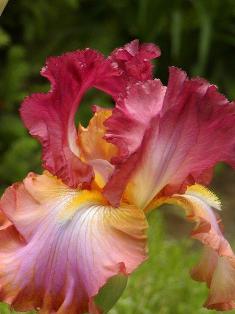
Welcome to the West Texas Iris Society
The West Texas Iris Society is a non-profit affiliate of the American Iris Society. Our purpose is to promote the growth and enjoyment of the Iris. Special thanks to Mullen and Mullen for helping make our Dallas events possible.

AIS National Convention
Dallas, TX
May 11-16, 2022

ShowSchedule2009
West Texas Iris Show
April 18, 2022

Harbinger of Spring, 2022
Permian Basin Iris Show – Dallas, TX
April 25, 2022
WANT TO GET INTO THE AMAZING WORLD OF IRISES? HERE’S SOME INFO TO HELP YOU GET STARTED!
When to Plant Irises
- Plant irises in the late summer or early fall when night temperatures are between 40 and 50 degrees Fahrenheit. They will have plenty of time to establish themselves before winter. Because they go dormant in the middle of summer, tall bearded Iris varieties should be planted closer to autumn.
- You can plant bare rhizomes and irises that you have received in a container earlier in the year. It is better to plant them immediately than to wait for the perfect time.
How to Choose and Prepare a Planting Location
- Full sun is the best for iris blooms. Although they can tolerate half a day in the sun, it is not ideal. They won’t flower if they don’t get enough sunlight.
- Bearded Irises should not be shaded by other plants. They thrive in their own special beds.
- They like fertile soil that is neutral or slightly acidic. Learn more about soil preparation and soil amendments.
- Good drainage is essential all year. Irises love “wet feet but dry knees” and will not tolerate soil that is too wet in winter.
- Use a tiller to loosen the soil to a depth between 12 and 15 inches. Then, add a layer of 2- to 4-inch compost.
How to Plant Irises
- Plant the rhizome horizontally, leaving the top exposed for bare-root Irises. If you live in hot climates, the rhizome should be planted just below the soil surface.
- Rhizomes can be planted singly or in groups, up to two feet apart depending on their size.
- Dig a hole about 10 inches in diameter by 4 inches deep. Place the rhizome in the middle of the hole and make a ridge out of the soil. Spread the roots on both sides. Fill the hole with soil, and then firm it up. Leave the foliage and part of the Rhizome exposed.
- Tip It is easy to plant irises too deeply. These plants’ rhizomes should be exposed to the elements or covered lightly with soil in hot environments. They won’t thrive if they are buried too deep.
- Avoid mulching around the rhizome, as this could encourage rot.
- Get water thoroughly.
How to Grow Irises
- Use an all-purpose fertilizer to fertilize the plants in spring. Avoid using high-nitrogen fertilizers on the surface and avoid mulching with organic material, as this can encourage rhizomerot. Reblooming Irises are most effective when fertilized after each wave of flowering has ended.
- Don’t overwater your iris plants. Too much moisture can cause the roots (rhizomes) to rot. Especially during summer drought, water consistently and deeply.
- Keep rhizomes exposed. Iris rhizomes require a little sun and air to dry out, unlike bulbs which can thrive underground. They will rot if they are covered in soil or overcrowded with other plants. In spring, Irises might benefit from shallow mulching.
- Higher irises might need to be staked or they may fall over.
- Iris borers can be found in the leaves. These dark vertical lines, which may seem watery, can be seen in the leaves. Below are some pest tips.
- You should deadhead your flowers (remove all spent blooms). Bearded irises will flower sequentially from buds placed along their stems.
- When blooming has ended, trim the flower stems at the base. However, do not trim iris leaves once they have finished blooming. The leaves continue to photosynthesis and produce energy for next year’s growing. To discourage rot, cut off the brown tips and trim the flowering stalk to the rhizome.
- After a hard frost in the autumn, trim the foliage and remove any yellowed or spotted foliage.
- To eliminate borer eggs, remove and destroy iris leaves that have been affected by heavy frost. Check your local frost dates.
- Winter protection: Cover the rhizomes in sand and top it with a thin layer of evergreen boughs. This can be applied after the ground has frozen, then removed when the Forsythias flower the next spring.
- Remove winter mulch and all old leaves in the spring to encourage new growth and stop Iris borers.
